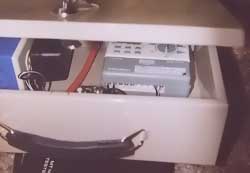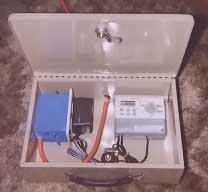Timer Controlled Key SafeSubmitted by: GaryDear AB, As you know, the subject of a timer controlled key safe has been brought up a number of times. There have been a few web sites that offered one, but no one I know had been able to obtain one. One CB manufacturer has one for the European folks, but it won't work here in the United States, or any country that uses 110/120 volt 60 cycle AC power. After looking at several ideas presented on this site, as well as some others, I decided to try and build one. There are more problems associated with this project than might initially be considered. Like what kind of material for the box? What kind of timing device? How will you control the locking mechanism? Do you want to be able to lock the device without the key? If so, how do you make that work? How do you mount the components inside without boring holes through to the exterior?
I decided early on that a solenoid that could block operation of the existing lock was necessary for cost reasons as well. Solenoids are relatively cheap compared to buying an electric striker plate, transformer and timer to run it. Those three items run about $250.00, you also then have to fabricate the box of some type of material, usually wood, to hold them. I'm not a very good wood worker and steel was out of the question. So what kind of solenoid and what kind of power to run it? AC or DC, what voltage and how long can it be energized without over heating? I looked at a bunch of options and finally it hit me, lawn sprinklers have solenoids, transformers and timers that all work together. They also are designed to be energized for a long period of time, up to the controllers time limit, usually 99 minutes. I finally found a solenoid that would work with a slight modification so I bought it, the cheapest controller the store had, and it came with the transformer. The sprinkler solenoid has another advantage. Since solenoids only work in one direction, some sort of return pressure is needed to push the plunger back out when the current goes off. The sprinkler solenoid has a built in spring! If I could figure it out, that would allow closing the key safe without having the solenoid energized as well.
I did discover a weakness in the design while working on setting the solenoid height. Since the lock won't operate without the solenoid being energized, I had the timer in manual mode trying to set the solenoid height and it turned off. I was locked out of the thing without the timer having been set to open again! I thought I had this contingency covered by removing the nut that held the lock in place. It would come out when I tried it before installing the solenoid. But with the solenoid mounted, the tang hit the body of it and would not tilt so I could remove it. I was just about ready to destroy the box and start over when I looked at the hinge for the lid, it is a piano hinge. I took that apart and got into the box again. This can be fixed by driving out the pin a little bit, cut off the pin about 1/4 inch, drive it back in, and fill the holes with metal set, epoxy or touch them with a welder. I'm going to do that as soon as I have completed my testing. I've found out the timer is really unforgiving of mistakes in the programming sequence.
I think it will work out okay, you can program the timer to open the box anything from one minute a week, to three times a day for up to 99 minutes each opening. One more thing about the solenoid, because it doesn't have water pressure holding it, it vibrates some when it's energized, it sounds like a buzzer inside the key safe so you know that it can now be opened. Some folks might not like being able to determine when the box can be opened, but since this will only stay open for a certain period of time and you can't see the timer, at least you can hear it when it can be opened. Right now I'm experimenting with twice a day the box opens for two minutes. You can get the key out but may not choose to use it. The key can be replaced and the box locked anytime, of course the timer is accessible while the lid is open. Maybe some your electronically minded visitors could come up with a better timer, that would not accept unauthorized re-programming, but this is my best effort. Hope it might give some of your readers a way to get a time controlled key safe of their own for a reasonable investment of time and money. The parts only cost about $55.00 and I think that's reasonable. Gary
[ Back to home built chastity page ] Page last updated 01-May-07 by: Altairboy@aol.com |


